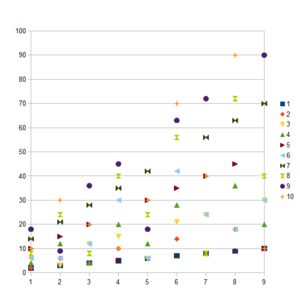Least common multiple facts for kids
The least common multiple (often called LCM) is a special number that helps us with math problems, especially when working with fractions. Imagine you have two numbers, like 4 and 6. The LCM of these numbers is the smallest positive number that can be divided by both 4 and 6 without any remainder.
Think of it like this:
- Multiples of 4 are: 4, 8, 12, 16, 20, 24...
- Multiples of 6 are: 6, 12, 18, 24, 30...
The numbers that appear in both lists are common multiples. The smallest one is 12. So, the LCM of 4 and 6 is 12.
We often write the least common multiple of two numbers, say a and b, as LCM(a, b).
Contents
What is a Multiple?
Before we dive deeper into the LCM, let's quickly remember what a multiple is. A multiple of a number is what you get when you multiply that number by another whole number (like 1, 2, 3, and so on).
For example:
- Multiples of 3 are: 3 × 1 = 3, 3 × 2 = 6, 3 × 3 = 9, 3 × 4 = 12, and so on.
- Multiples of 5 are: 5 × 1 = 5, 5 × 2 = 10, 5 × 3 = 15, 5 × 4 = 20, and so on.
The least common multiple is the smallest number that is a multiple of all the numbers you are looking at.
Why is LCM Important?
The LCM is super useful when you need to add, subtract, or compare fractions. When you have fractions with different bottom numbers (denominators), you need to find a "common denominator" before you can do anything with them. The smallest common denominator is actually the least common multiple of the original denominators! This is why it's sometimes called the "least common denominator" (LCD).
For example, to add 1/3 and 1/4:
- The denominators are 3 and 4.
- The LCM of 3 and 4 is 12.
- So, you change 1/3 to 4/12 and 1/4 to 3/12.
- Then you can add them: 4/12 + 3/12 = 7/12.
LCM and Greatest Common Divisor
The least common multiple (LCM) has a cool connection with another important math idea called the greatest common divisor (GCD). The GCD is the largest number that divides into two or more numbers without leaving a remainder.
For any two numbers, say a and b, if you multiply their LCM by their GCD, you will get the same answer as multiplying the two numbers themselves.
This can be written as a formula:
- GCD(a, b) × LCM(a, b) = |a × b|
This formula is often used by mathematicians to find the LCM if they already know the GCD, or vice versa!
Related pages
See also
 In Spanish: Mínimo común múltiplo para niños
In Spanish: Mínimo común múltiplo para niños


